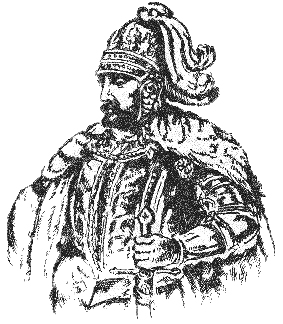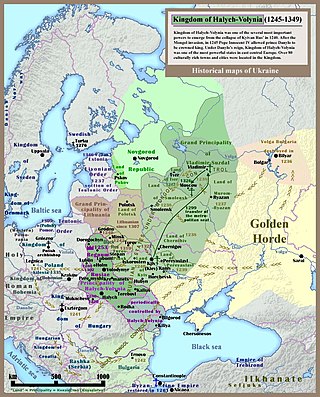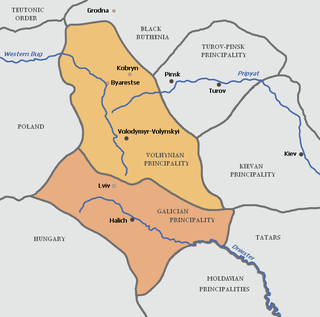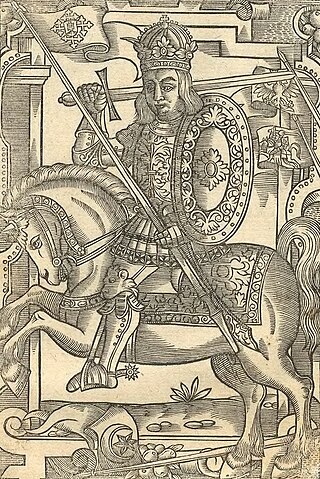The Grand Prince of Kiev was the title of the monarch of Kievan Rus', residing in Kiev from the 10th to 13th centuries. In the 13th century, Kiev became an appanage principality first of the grand prince of Vladimir and the Mongol Golden Horde governors, and later was taken over by the Grand Duchy of Lithuania.

The Principality or, from 1253, Kingdom of Galicia–Volhynia, also known as the Kingdom of Ruthenia, was a medieval state in Eastern Europe which existed from 1199 to 1349. Its territory was predominantly located in modern-day Ukraine, with parts in Belarus, Poland, Moldova, and Lithuania. Along with Novgorod and Vladimir-Suzdal, it was one of the three most important powers to emerge from the collapse of Kievan Rus'.

Algirdas was Grand Duke of Lithuania from 1345 to 1377. With the help of his brother Kęstutis he created an empire stretching from the present Baltic states to the Black Sea and to within 80 kilometres of Moscow.

Demetrius of Liubar or Liubartas was Prince of Lutsk and Liubar (Volhynia) (1323–1383), Prince of Zhytomyr (1363–1374), Grand Prince of Volhynia (1340–1383), Grand Prince of Halych–Volhynia (1340–1349).

Leo II of Galicia, also known as Lev Yurevich was Prince of Lutsk and Galicia, one of the last two Romanovichi kings of Rus`. He was a member of the senior branch of Monomakhovichi.

The family of Gediminas is a group of family members of Gediminas, Grand Duke of Lithuania, who interacted in the 14th century. The family included the siblings, children, and grandchildren of the Grand Duke and played the pivotal role in the history of Lithuania for the period as the Lithuanian nobility had not yet acquired its influence. Gediminas was also the forefather of the Gediminid dynasty, which ruled the Grand Duchy of Lithuania from 1310s or 1280s to 1572.
Fiodor was the prince of Kiev until 1362. Most likely he was the son of Butvydas, and a younger brother of Gediminas, the grand duke of Lithuania, his pagan name is unknown and he was baptized as Orthodox Fiodor. Only a couple of short notes survive regarding Fiodor's life.

The Principality of Pereyaslavl was a regional principality of Kievan Rus' from the end of 9th century until 1323, based in the city of Pereyaslavl on the river Trubizh.

The Galicia–Volhynia Wars were several wars fought in the years 1340–1392 over the succession in the Kingdom of Galicia–Volhynia, also known as Ruthenia. After Yuri II Boleslav was poisoned by local Ruthenian nobles in 1340, both the Grand Duchy of Lithuania and the Kingdom of Poland advanced claims over the kingdom. After a prolonged conflict, Galicia–Volhynia was partitioned between Poland (Galicia) and Lithuania (Volhynia) and Ruthenia ceased to exist as an independent state. Poland acquired a territory of approximately 52,000 square kilometres (20,000 sq mi) with 200,000 inhabitants.
The Battle of Blue Waters was fought at some time in the autumn of 1362 or 1363 on the banks of the Syniukha River, a left tributary of the Southern Bug, between the armies of the Grand Duchy of Lithuania and the Golden Horde. The Lithuanians won a decisive victory and finalized their conquest of the Principality of Kiev.

The Council of Liubech was one of the best documented princely meetings in Kievan Rus' that took place in Liubech on October 19, 1097. The council ended the Chernihiv war of succession (1093–1097) between Sviatopolk II of Kiev, Vladimir II Monomakh and Oleg I of Chernigov who fought for the heritage of his father Sviatoslav II of Kiev.

The Principality of Turov, later called the Principality of Turov and Pinsk, also known as Turovian Rus', was a medieval principality of Kievan Rus' from the 10th century on the territory of modern-day Belarus and northern Ukraine. The princes of Turov often served as grand princes early in 10th and 11th centuries. Its capital was Turov (Turaŭ), and other important cities included Pinsk, Mazyr, Slutsk, Lutsk, Brest, and Volodymyr.
The Metropolis of Lithuania was a metropolis of the Ecumenical Patriarchate of Constantinople in the Eastern Orthodox Church. It was erected on the territory of the Grand Duchy of Lithuania between 1315 and 1317. It was disestablished in 1371. The seat (cathedra) of the metropolis was initially in Navahrudak. It had only two metropolitan bishops. The establishment took place in the aftermath of the Mongol invasion of Kievan Rus' which was exploited by the rulers of Lithuania to greatly expand their territory. To help legitimize their annexations and to bind their new subjects more closely to the state, the royal powers favoured the erection of a metropolis for the inhabitants of the Grand Principality. To avert the possibility of the state going over to the Holy See, the hierarchs based in Moscow latterly supported the erection of the metropolis as the lesser of two evils. Throughout the existence of the metropolis, the metropolitans struggled for religious control of the Rus' eparchies with the secular and religious powers in the Kingdom of Galicia–Volhynia, the Principality of Tver, and the Grand Duchy of Moscow.

The Principality of Volhynia was a western Kievan Rus' principality founded by the Rurikid prince Vsevolod in 987 centered in the region of Volhynia, straddling the borders of modern-day Ukraine, Belarus, and Poland. From 1069 to 1118, it belonged to Izyaslavichi who primarily ruled from Turov. After losing Turov to Monomakhovichi in 1105, the descendants of Iziaslav Yaroslavovich for a few years continued to rule in Volhynia. From 1154 to 1199, the Principality was referred to as the Principality of Volodymyr when the Principality of Lutsk (1154–1228) was separated.

Mindaugas was the first known grand duke of Lithuania and the only crowned king of Lithuania. Little is known of his origins, early life, or rise to power; he is mentioned in a 1219 treaty as an elder duke, and in 1236 as the leader of all the Lithuanians. The contemporary and modern sources discussing his ascent mention strategic marriages along with banishment or murder of his rivals. He extended his domain into regions southeast of Lithuania proper during the 1230s and 1240s. In 1250 or 1251, during the course of internal power struggles, he was baptised as a Roman Catholic; this action enabled him to establish an alliance with the Livonian Order, a long-standing antagonist of the Lithuanians. By 1245, Mindaugas was already being referred to as "the highest king" in certain documents. During the summer of 1253, he was crowned king, ruling between 300,000 and 400,000 subjects and got nicknamed as Mindaugas the Sapient by the Livonians.

Gediminas was Grand Duke of Lithuania from 1315 or 1316 until his death in 1341.
The Metropolis of Halych was a metropolis of the Ecumenical Patriarchate of Constantinople in the Eastern Orthodox Church. It was erected on the territory of the Kingdom of Galicia–Volhynia in 1303 by Patriarch Athanasius I of Constantinople. The episcopal seat of the metropolis was in the city of Halych in the "Cathedral of the Assumption".
The Metropolis of Kiev and all Rus' was a metropolis of the Eastern Orthodox Church that was erected on the territory of Kievan Rus'. It existed between 988 AD and 1596 AD. Canonically, it was under the jurisdiction of the Ecumenical Patriarchate of Constantinople. The episcopal seat (cathedra) was located in the city of Kiev until it was moved to Vladimir-na-Klyazme in 1299 and then Moscow in 1325.
George Koriatovich, also known as George Korjatowicz or Jurg Korjat, was a Lithuanian prince from the Gediminid dynasty. He was prince of Podolia together with his two brothers from around 1363. George closely cooperated with Casimir III of Poland against his Lithuanian kinsmen who had absorbed parts of the Kingdom of Galicia–Volhynia. He was elected voivode of Moldavia in 1374, but his Vlach subjects murdered him in 1375 or 1377.












